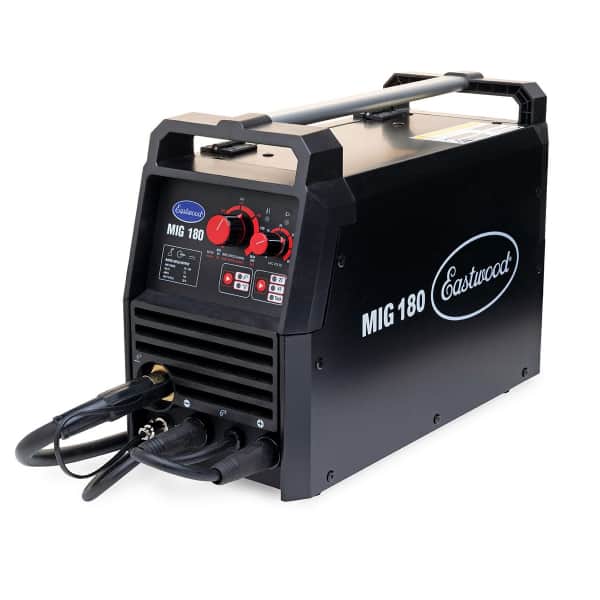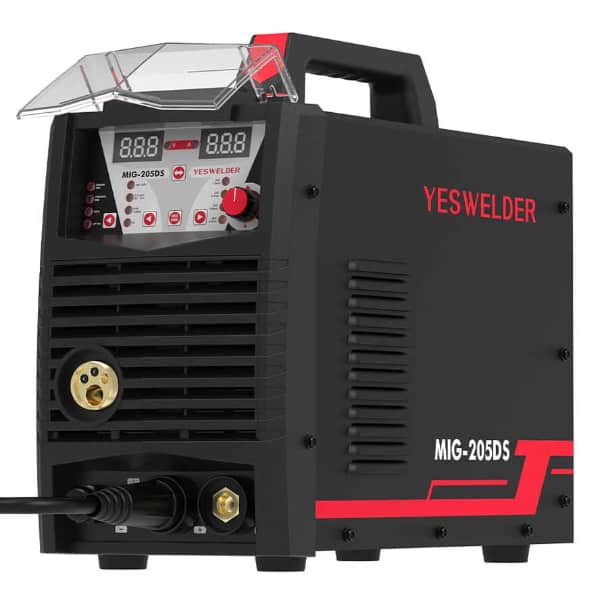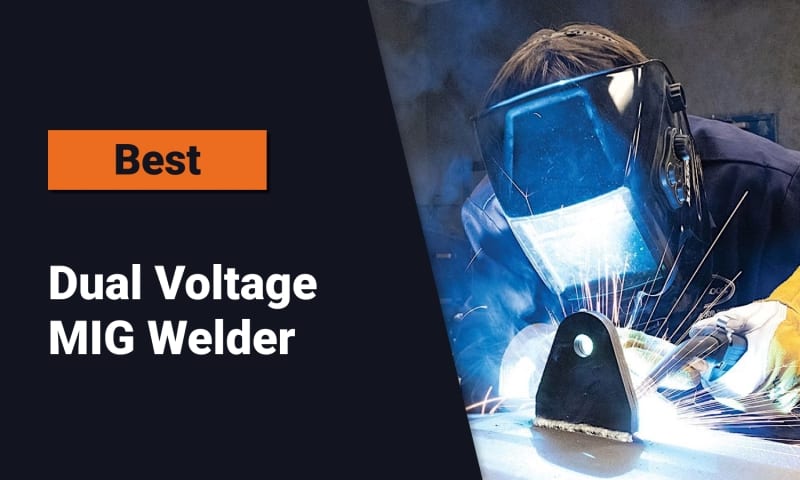Dual-voltage MIG welders combine the versatility of welding with a 110V input with the high power output available from a 220V outlet all in one machine.
If you are a hobbyist that occasionally needs more power or a professional requiring versatility, dual-voltage is a must. So, since these machines also appeal to professionals, manufacturers often include other useful functions.
In this article, you’ll discover the 7 best dual-voltage MIG welders. We cover where each shines and the users who will benefit the most from them. No matter your level of experience, there is a welder on this list for you.
A Quick Comparison
| Product | |||
|---|---|---|---|
| Image | Product | Details | |

|
Eastwood MIG 180 |
High build quality Spool gun support Best alternative for Hobart 210 |
|

|
YesWelder MIG-205DS |
Most popular amongst beginners Feature-rich High duty-cycle and power output |
|

|
Firepower FP-200 |
Excellent build and arc quality Feature-rich Made by ESAB |
|

|
Everlast Power-i MIG Cyclone 200E |
Digital Display Automatic settings 5-Year warranty |
|

|
Millermatic 211 |
Best build and arc quality Automatic and manual settings 3-Year warranty |
|

|
Hobart Handler 210MVP |
Transformer core Excellent arc quality Made in the USA |
|

|
Lincoln Electric Power MIG 180 |
Transformer-core Portable Great arc stability |
Best Dual Voltage MIG Welder Reviews
Every welding shop is different, and not everyone needs a high-end, professional-grade MIG welder. So, our first two picks are excellent choices for hobbyists who want useful functions and durability at a low cost. Further on in our review, we also cover multiple high-end MIG units for working professionals.
1. Eastwood MIG 180 Dual Voltage Welder

- Excellent build and arc quality for a low price
- Supports spool gun for welding aluminum
- Lightweight
- It uses a recently updated inverter that supports generator power
- Includes 2T/4T and tack weld modes
- Maximum 180A output at 30% duty cycle
Pros
- Durable build
- Excellent arc quality
- Great value compared to the Hobart 210
- Portable and light at just 25 lbs
- Infinite adjustability
- Up to 551 IPM wire feed speed
- Supports tack weld mode for consistent spot welds
- Spool gun support
- Decent duty cycle with 220V input
- 3-Year warranty
Cons
- Low duty cycle using 110V input
- No digital display
- Not many advanced functions included
Overview
The Eastwood MIG 180 misses some features found on the YesWelder above, like digital displays, inductance control, and Synergic MIG for auto settings. However, it’s produced by an established USA brand, comes with a 3-year warranty, and offers a better arc and build quality.
Since it’s just slightly more expensive than the YesWelder MIG-205DS, we believe the Eastwood MIG 180 offers better value for users requiring durability. The Eastwood MIG 180 is a reliable welder; even professionals can use it for light-duty jobs.
However, the MIG 180 has a relatively low duty cycle with the 110V input, like most MIG welders (full MIG 180 review here). This is not an issue if welding the thin sheet metal. But, the machine can’t handle thicker sections without pausing now and then.
Still, the Eastwood MIG 180 is a steal for hobbyists and less demanding shops. Plug it into a 220V outlet, and you’ll get a decent duty cycle and up to 551 inches per minute (“IPM”) of wire feed speed, allowing you to weld thicker metal with root gaps and heavily beveled edges.
2. YesWelder MIG-205DS Dual Voltage MIG Welder

- Supports MIG, flux-cored, TIG, and stick welding processes
- Highest duty cycle and amperage output at 110V input
- Inverter-based and exceptionally light
- Includes automatic and manual adjustments
- It supports numerous helpful functions
- Intuitive controls and two digital displays
Pros
- Smooth, stable arc
- Inexpensive
- Highest amperage output with 110V in our review
- Highest duty cycle on our list
- Supports 2T/4T, manual wire feeding, gas check, and inductance settings
- Synergic MIG auto-sets voltage according to the wire feeding speed
- It also includes DC TIG and SMAW welding
- It uses two digital displays
- Infinite adjustability
- Ultra-lightweight, just 23 lbs
- 1-year warranty
Cons
- TIG torch not included
- It doesn’t support a spool gun for welding aluminum
Overview
The YesWelder MIG-205DS is an inexpensive and hugely popular dual-voltage multi-process welder designed with a focus on the MIG welding process. YesWelder is known for hobbyist-grade welding equipment. But, they often hit that sweet spot between low cost and quality. That is especially true for the MIG-205DS.
While this welder offers dual-voltage input, you’ll rarely need to plug it into a 220V receptacle. The 110V input provides up to 160A of output at a 60% duty cycle. But, the 220V input packs a 205A punch with a 60% duty cycle. However, we don’t expect the MIG-205DS to handle the daily demands of professional work. This is a hobbyist welder, and you should treat it as such (full MIG-205DS review here).
The MIG-205DS offers more features than most brands. Along with the MIG and flux-cored processes, it supports stick and TIG welding. Additionally, it includes an inductance setting for MIG, automatic and manual adjustments, and 2T/4T modes.
The welder has good build quality considering the low cost. But it stands out by combining two digital displays, infinite adjustability, DINSE connectors, and an all-metal wire drive system at an impossibly low cost. The price for all these included features makes the YesWelder MIG-205DS the best budget dual-voltage MIG welder. You can save 10% with the discount code “WELDGURU10” that was found online.
3. Firepower FP-200 Dual Voltage MIG Welder

- Time-proven, high-end quality by ESAB
- Includes features like MIG inductance, 2T/4T, wire burnback time, etc.
- Digital display and infinite adjustability
- Inverter-based power provides low weight and portability
- Generator-friendly
- Spool gun support
- Maximum output of 200A at a 15% duty cycle
Pros
- Made by ESAB
- Best build and arc quality in its price range
- Includes numerous features for professional arc management
- Lightweight at 30 lbs
- Includes Tweco MIG gun and copper-stripped ground clamp
- Supports Tweco spool gun for aluminum
- Excellent digital display contrast and readability
- 3-Year warranty
Cons
- Low duty cycle, considering it’s designed for professionals
- MIG gun is rated for 180A, 20A less than the machine’s maximum output
Overview
If you are looking for a professional MIG welder with an excellent price-to-value ratio, the Firepower FP-200 by ESAB is worth considering. The only downside of the FP-200 is a low duty cycle. You can’t do heavy-duty jobs since the machine sustains 200A output for just 90 seconds.
But, if you mostly weld thinner metals or don’t perform high-volume welding, the FP-200 is a good choice for professionals. It’s light, portable, and generator-friendly. So, it works where you do.
The digital display has an intuitive menu, and the infinite adjustability lets you fine-tune all settings, including inductance, wire run-in, and burnback time. The display shows wire feed speed (like all MIG welders), but it also indicates actual amperage output. This is not often the case, most MIG machines leave you guessing exactly how many amps you are using.
The Firepower competes well against brands like Lincoln, Hobart, and Miller in terms of arc and build quality, but it’s priced much more aggressively.
4. Everlast Power-i MIG Cyclone 200E

- Includes automatic and manual settings
- Large digital display
- Supports a spool gun for aluminum
- Inverter-based and lightweight
- 25% Duty cycle at 180 amps
Pros
- Great arc quality
- Large display with intuitive controls
- Supports automatic settings based on material thickness
- Excellent MIG torch for the price
- Flowmeter included (instead of a basic dual-gauge regulator)
- Spool gun support
- Lightweight
- 5-Year warranty
Cons
- Aluminum mode requires you to use the “C25” setting, implying that you need a 75/25 CO2/Ar for aluminum, which is incorrect. You must use 100% argon.
- No inductance, 2T/4T, or other advanced settings
- Ground clamp lead is a measly 5 ft.
Overview
If you are on a tight budget, but want to start welding professionally, the Everlast Cyclone 200E may be a good choice. Automatic settings and a 5-year warranty make for a solid, easy-to-use unit.
But other than that, it doesn’t offer anything better than the Eastwood MIG 180. In general, the Everlast Cyclone 200E doesn’t include advanced functions and opts for a design that allows quick and easy welding.
Its automatic “PowerSet” mode sets everything for you in seconds. This is helpful for rookies and professionals because it saves time and provides the correct settings. But that also means you can’t modify bead width and height with an inductance setting, use 4T mode, tack weld, or set wire burnback time.
Additionally, the included ground clamp is a mere 5 feet long. That’s unacceptable for professional work, so you’ll have to upgrade it. On the other hand, the provided MIG gun at this price exceeds all expectations, beating out the one that comes with the similarly priced Eastwood MIG 180 and the YesWelder MIG-205DS.
5. Miller Electric Millermatic 211

- Exceptional build and arc stability
- Angled, cast aluminum wire drive system
- Up to 600 IPM wire feed speed
- Generator compatible
- Automatic and manual controls
- Inverter-based, light, and portable
- Automatically detects spool gun
Pros
- Best arc stability offered by dual-voltage MIG welders
- Top-of-the-line build quality
- Angled cast aluminum wire drive
- Miller’s “SmoothStart” technology outputs spatter-free arc
- It doesn’t require more than a 7KW generator to output full 200A
- Quick select drive roll drastically reduces the time needed to change the wire drive setup
- Automatic settings
- High maximum wire feed speed
- Decent duty cycle with 220V input
- 3-Year warranty
Cons
- Low duty cycle with 110V input
- No display
- It doesn’t support inductance, 2T/4T, and other manual settings
- Integrated ground clamp
- Requires manual rewiring the polarity terminals inside the wire compartment
- Expensive
Overview
Pure and simple, the Millermatic 211 is the best dual-voltage MIG welder for professionals. It’s been designed for daily welding at the shop or in the field. And it delivers, handing the demands of light to medium shops, tackling far more work than competing welders.
The maximum 600 IPM wire feed speed allows you to deposit filler metal rapidly, bridge the gap on large root openings, and achieve excellent penetration. However, Millermatic’s duty cycle limits heavy-duty applications. The duty cycle is slightly better than the FP-200, offering 2 minutes of welding at 200A.
The automatic mode is exact and supports all MIG welded metals. However, the manual mode provides arbitrary 1-10 and 10-100 values for voltage and wire feed speeds. We expect “real” numbers for welders in this price category. Professionals don’t want to guess when it comes to their settings.
Unfortunately, it doesn’t have a display or advanced functions like 2T/4T, inductance, wire burnback time, and others. If you don’t need maximum reliability, you should probably consider a lower-cost alternative with more features like the Firepower FP-200.
6. Hobart Handler 210MVP

- Best-in-class arc and build quality
- Transformer-core for maximum durability
- Relatively portable
- Supports a spool gun
- Up to 770 IPM wire feed speed
- Angled, cast aluminum wire drive system
Pros
- Best arc and build quality in its price category
- Transformer-core ensures longevity
- Supports welding aluminum
- Highest wire feed speed on the market among portable MIG welders
- Angled cast aluminum drive improves wire feed stability
- Quick select drive rollers
- Hobart’s 5/3/1 warranty
Cons
- Low duty cycle
- No DINSE support
- Integrated ground clamp
- Pre-set voltage output values
- Doesn’t include settings for arc control
- No display
- Overpriced
Overview
Unlike the Millermatic 211, the iconic Hobart 210MVP is transformer-based. This welder was one of the most popular portable MIG welders when it launched. However, after many years the Hobart 210 is no longer competitive in vital areas.
The Handler 210 is portable but weighs almost 80 lbs. Compare that to inverter-based MIG machines, which weigh as little as 25 lbs. Additionally, it doesn’t have any settings for arc control or standard DINSE connectors, and the integrated ground clamp makes the polarity switching for the flux-cored welding process far more complex.
However, with a maximum wire feed speed of 770 IPM, the Handler deposits filler metal exceptionally fast. This allows easy gap bridging and deeper penetration.
The Hobart Handler 210MVP is a USA-made welder with excellent arc and build quality. But, other than that, it doesn’t compare well to the Eastwood, Everlast, or Firepower welders we saw earlier. They are far less expensive and offer more features.
7. Lincoln Electric Power MIG 180

- Transformer-based
- Relatively portable
- Spool gun ready
- Enhanced arc stability for out-of-position welding
- 30% duty cycle at 130A output
Pros
- Lincoln’s diamond-core technology improves arc stability
- Transformer-core improves longevity
- Angled cast aluminum drive
- Supports spool gun
- Excellent build quality
- 3-Year warranty
Cons
- Heavy at 68 lbs
- No advanced functions
- It doesn’t have a display and DINSE connectors
- Pre-set voltage output values
- Integrated ground clamp
- Requires manual polarity switching inside the welder
- Weak duty cycle
- Low wire feed speed
- Expensive
Overview
The Lincoln Electric Power MIG 180 has a lower amperage output than Hobart’s 210. But, it’s also lighter and more portable. Both are transformer-based, but the Power MIG 180 has a more optimized arc for out-of-position welding, making it a better choice for welding shops.
Unfortunately, due to the severely limited duty cycle, every welder on our list is a strong competitor to the MIG 180 unless you mostly weld sheet metal. The lack of DINSE connectors and advanced arc controls makes it overpriced.
On the other hand, Lincoln Electric is a well-known brand with excellent support, just like Miller and Hobart. The Power MIG 180 comes with a 3-year warranty and excellent build quality. Still, since it costs nearly as much as the Millermatic 211, it’s too expensive in our opinion.
Buyer’s Guide
To help you make the right MIG welder choice, we prepared a concise buying guide below.
Are Dual-Voltage Welders Any Good?
Dual-voltage MIG welders are an excellent option if you need the versatility of a 120V input combined with the power from a 220V power supply when available. It’s the best of both worlds, power when you need it and welding wherever the work takes you without the limitation of needing a 220V outlet.
What To Look For In a Dual-Voltage MIG Welder
Here’s a quick rundown of what to look out for in your dual voltage MIG welder:
- Spool gun support is necessary if you wish to weld aluminum
- Digital displays make fine-tuning the arc straightforward, especially for beginners
- Synergic MIG and other automatic settings remove the guesswork and help get the job done faster
- 4T mode allows you to weld without keeping the MIG gun trigger depressed
- Transformer-based MIG welders usually offer better longevity, while inverter-based units have far lower weight and they usually offer additional functions
- DINSE connectors are a standard nowadays; they allow easy replacement of worn leads and quick polarity switchovers
- High wire feed speeds provide deeper penetration and a high filler metal deposition rate
- The duty cycle represents how long the welder can sustain the rated output over a 10-minute interval (e.g., a 20% duty cycle at 150A means that the welder can weld for 2 minutes at that amperage before resting another 8 minutes)
Wrapping Up
To select the best dual-voltage MIG welder for you, first consider your welding needs. If you are a hobbyist or just getting started with the MIG welding process, the YesWelder MIG-205DS and the Eastwood MIG 180 are your best choices. They are inexpensive and fine if you don’t need shop-level durability or arc quality.
But, if you need more durable machines, the Firepower FP-200 and Millermatic 211 are your best bet. The Firepower is less expensive and offers numerous functions that the Millermatic doesn’t. However, the Millermatic has a slightly better arc and build quality. Plus, the automatic settings available on the Millermatic 211 are fine-tuned for all commonly welded materials.


